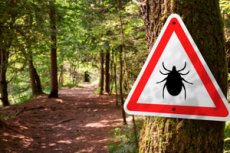New publications
Tick season is upon us. Protect yourself with these tips
Last reviewed: 02.07.2025

All iLive content is medically reviewed or fact checked to ensure as much factual accuracy as possible.
We have strict sourcing guidelines and only link to reputable media sites, academic research institutions and, whenever possible, medically peer reviewed studies. Note that the numbers in parentheses ([1], [2], etc.) are clickable links to these studies.
If you feel that any of our content is inaccurate, out-of-date, or otherwise questionable, please select it and press Ctrl + Enter.

Tick season is starting, and experts warn that the bloodsuckers could be as numerous as last year.
Another mild winter and other favorable factors likely mean tick populations in 2024 will be equal to or greater than last year, according to some researchers.
"The situation is very bad and getting worse," said Suzanne Visser of the Centers for Disease Control and Prevention (CDC).
Tick diversity is expanding into new geographic areas, bringing with it unusual diseases. Exotic southern species such as the Gulf of Mexico tick and the solitary star are being found in New York and other northern states.
But experts are most wary of the common black-legged tick, which is found mostly in forests and spreads Lyme disease. The disease peaks in May, and U.S. health officials estimate that nearly half a million cases of Lyme disease occur each year.
Facts about ticks
Ticks are small, eight-legged, blood-sucking parasites that belong to the class of arachnids, not insects, that feed on animals and sometimes humans. Some ticks are infected with disease-causing microorganisms and spread them when they bite.
While there is no accurate annual tick count, there is scientific consensus that they are becoming an increasingly common health threat in large parts of the United States.
Black-legged ticks — also known as deer ticks because they feed on deer — are one of the most common ticks in the eastern half of the United States. Their numbers were significant for centuries, then declined with logging and deer hunting, and increased again with the resurgence of deer populations and suburban woodlands. The ticks have spread from local hotspots in New England and the Midwest to a wider area, including the South and the Great Plains.
Tick populations cycle throughout the year and are affected by several factors. They prefer warm, humid weather and are more common after a mild winter. The number of deer and mice available also plays an important role.
Overall, the black-legged tick population has been expanding for more than four decades, the researchers say.
"It's a slow-moving epidemic," said Rebecca Eisen, a biologist and tick expert at the CDC.
What is Lyme disease?
Not all ticks are infected with disease-causing microorganisms. Experts estimate that about 20% to 30% of black-legged tick larvae that emerge in the spring and summer in the Northeast and Midwest carry the bacteria that cause Lyme disease.
Symptoms of Lyme disease usually begin three to 30 days after a tick bite and may include fever, headache, fatigue, and a target-shaped rash. If you are bitten by a tick and have symptoms, see a doctor for antibiotic treatment.
How to protect yourself from tick bites
Experts say the best thing to do is take steps to prevent a tick bite.
If you go outside, pay attention to wooded areas and places where grass meets wood. Ticks are usually found on vegetation at ankle level, with their front legs outstretched, waiting to latch onto an unsuspecting person or dog.
Try to walk in the middle of paths, wear light-colored and permethrin-treated clothing, and use EPA-registered repellents.
How to check for ticks?
When you go indoors, check yourself for ticks. They can be anywhere on the body, but are often found around the waist, behind the knees, between the fingers, under the arms, in the belly button, and around the neck or hairline.
They are harder to see when they are young, so look closely and remove them immediately with tweezers.
The CDC does not recommend sending individual ticks for testing because a person may have more than one tick bite and the test results may not provide enough information.
